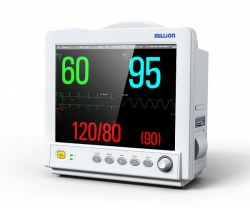Wechat QR code

TEL:400-654-1200

TEL:400-654-1200

Ecg monitor alarm: what are the common reasons? How?
Monitor manufacturers Ecg monitor is widely used in clinic, and it is required that the alarm is in an open state during use. Can monitor alarm settings be turned off? How to set the alarm value? This article discusses the common alarm settings of monitors.

Question 1: why should monitor alarm settings be turned on?
Reasonable monitoring alarm settings can remind medical staff to discover and deal with sudden life-threatening events in time by presetting the safety range of alarms, and it can timely reflect the problems existing in heart rate, respiration, blood pressure, pulse and ECG waveforms of patients, and feed them back to medical staff, which is convenient for medical staff to grasp the patient's condition changes in time, and brings convenience to clinical treatment and nursing work.
Question 2: how many kinds of monitors alarm?
The alarm classification of the monitor in the instruction manual is relatively complicated. Generally, it can be divided into the following categories:
1. level 1 alarm ( red ): if the illness changes, it must be handled immediately.
2. secondary alarm ( yellow ): relatively deferrable treatment.
3. technical alarm: check whether the parameter settings are reasonable or not.
Question 3: how do you understand the alarm safety range?
Setting the alarm value of safe range refers to setting the upper and lower limits of the alarm according to the patient's clinical situation, rather than simply setting it according to the increase or decrease of normal values of heart rate, respiration and blood pressure by a certain proportion, so as to make it within safe range. If the normal range is set, the monitor will alarm frequently, which will eventually lead to the paralysis of medical staff.
For example, as compared with patients with type I respiratory failure, a considerable part of type ii respiratory failure is caused by acute attack of COPD, and such patients have higher tolerance to hypoxia, so the setting of spo 2 lower limit can be relaxed appropriately. The safety range of setting blood pressure alarm parameters is different between hypertensive patients and hypotensive patients. Therefore, after evaluating the patient's existing vital signs, we should set its alarm range by 20 % - 30 % on this basis.
Question 4: what are the requirements for setting alarm parameters?
The mechanism of limit alarm is to set alarm limits for parameters, and alarm will be given when the monitored value reaches the set limit or exceeds the limit for a certain time. This idea is helpful to find that a certain parameter exceeds the physiological limit, however, a certain parameter can not reflect the overall situation of the patient, and the normal range of change of a certain parameter in physiological condition is very wide. Except arrhythmia, alarms of heart rate, respiration, blood pressure and oxygen saturation are all limit alarms. The principles of alarm setting of monitor include:
1. the heart rate is 30 % of its own heart rate.
2. blood pressure according to the doctor's advice, the patient's condition and basic blood pressure settings.
3. oxygen saturation is set according to the condition ( COPD patients, ARDS patients and general pulmonary infection patients ).
4. the setting of alarm volume must ensure that nurses can hear it within the scope of work.
5. the alarm range should be adjusted at any time according to the situation, and check whether the setting is reasonable at least once per shift.